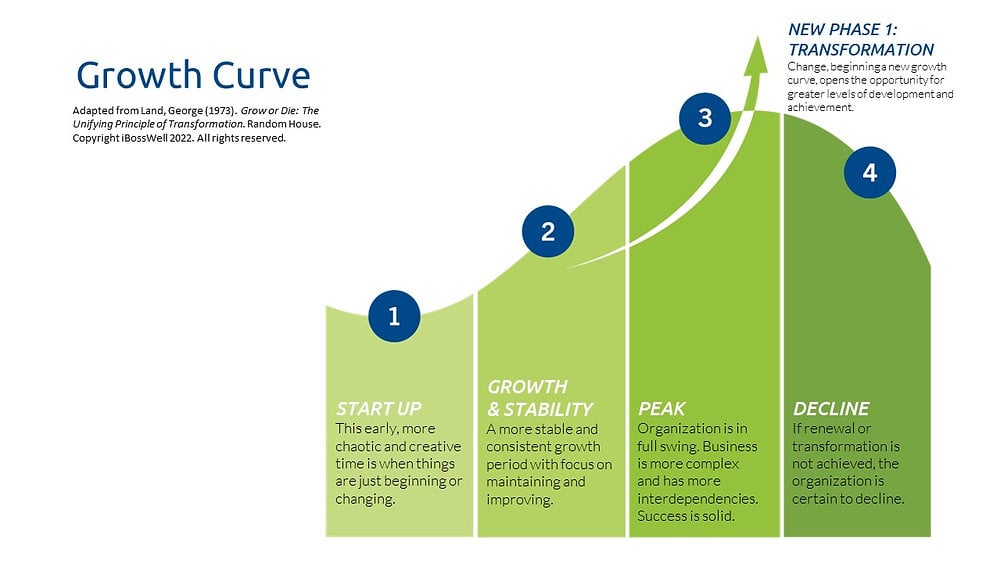“Grow or Die”—a profound statement, right? George Land, PhD, originally published his book, Grow or Die: The Unifying Principle of Transformation* in 1973. Adapted from Land’s theory and model, the “Growth Curve” simply illustrates the complex principles of growth, change and transformation.
Land’s theory and research around growth and transformation has become a cornerstone in the strategic planning and organizational transformation world. Land’s Transformation Theory – a theory of natural processes that integrates principles of creativity, growth, and change – led to his development of unique strategic thinking and innovation processes for organizations. The book’s publisher, Random House, submitted Grow or Die as its nominee in the science category for the Pulitzer Prize and National Book Award.
IBW applies this theory to organizations and teams within organizations, using the Growth Curve to identify three initial phases of organizational development and transformation:
-
Phase 1-Start Up
-
Phase 2-Growth and Stability
-
Phase 3-Peak
Which can then lead to a Phase 4-Decline. However, there is an alternative to Phase 4!
-
Phase 1-Start Up is chaotic. It is also creative. Many things are new and not yet well-defined. Some people thrive in this innovative and creative design phase, others are shut down, or at least frustrated by the chaos and ambiguity. As a leader understanding that about half, or fewer of your people love Phase 1, while the silent majority are uncomfortable to downright angry or resistant, is key to better managing these dynamics. Those folks uncomfortable with the chaos need the order and clarity of defined roles, processes and systems – then they are happy to do their work. Without this, they struggle. As a leader, or one of those lovers of Phase 1, don’t get annoyed with these folks. Rather, revere them, as you need these fine workers to steer you through Phase 2. Don’t discount or pressure them to ‘get on the train’ here. Rather, support them and empathize with their frustration, acknowledging that greater clarity is needed, and thankfully is on the way with Phase 2 just around the corner! As a matter of fact, they might even be able to help (if this fits in their skill set), by working on a particular project, like redefining a job description to fit in the new paradigm. Knowing that leadership acknowledges the challenges of this phase and are not just twiddling their thumbs, but intentionally working to get to Phase 2 can greatly relieve some of the innate stress of Phase 1.
-
Phase 2-Growth and Stability. This period brings more stable, consistent growth, with a focus on maintaining and improving the organization and all within it. Phase 1 resistors are typically quite happy here and enjoy the clarity that has been gained that guides their work and performance; leaders continue to support and encourage here, and always seek for clarity. For the Phase 1 lovers, rather than watching them get bored, offer them opportunities to help the growth curve keep rising with new projects, innovation, research and the like; these are your future change agents for the next Phase 1 down the road, keep them stimulated!
-
Phase 3-Peak. This is the time when the organization is in full swing. Business is more complex and more interdependent on multiple factors for achievement. Success is solid and perhaps exceeding expectations! As a leader, as great as this feels, don’t fall into riding the wave too long here, without planning for what it is going to take to start a new Phase 1. Late Phase 2, early Phase 3 is the ideal time to start planning the next renewal/transformation Phase 1 cycle.
-
The faltering end is Phase 4-Decline. If renewal or transformation is not achieved, the organization is certain to decline. Watching for signs of decline internally, is what many leaders do, which is often too late to more readily transform. Keeping your finger on the pulse of the external environment that influences your organization is key to being proactive and avoiding the decline of Phase 4. Building in processes/practices that enables a steady watch on threats and opportunities, then being open and agile to adapting to these significant environmental changes is key to avoiding Phase 4.
The only way to avoid Phase 4 is to begin a new growth curve to open new opportunities for development and achievement. Change therefore, is not only inevitable, but healthy. The challenge is to recognize and accept that the creative process is constantly pulling all systems to a future different from the past. Aligning with this process requires being open to making new and different connections with people, ideas, resources, and opportunities. Successful organizations continue to cycle through Phases 1 – 3 and then transform to a new Phase 1 – and, it is a high art to keep a balance between not cycling too often with waiting too long. Following the recommendations above can significantly help to keep that balance and continue to take your organization to the next level of excellence and performance!

